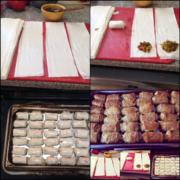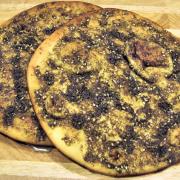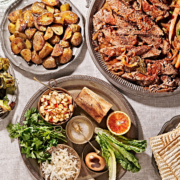Great Tips on Working with Fillo Dough
I’ll make a Fillo dough pro out of you. Stick with me!
The good news is, fillo dough is wonderfully versatile, melt-in-your-mouth delicious and wonderfully crunchy. We Moroccans and other Mediterranean food lovers and beyond couldn’t be without it. Amazing, when you think fillo contains nothing more than flour and water, and a dash of salt. It lends itself perfectly to countless sweet and savory dishes, both shaped in individual servings and prepared in large trays scored along individual servings: the Turkish-born Baklava, the Moroccan Almond Pastries, the Greek spinach-feta favorite Spanakopita, the beloved Moroccan Pastilla, the Eastern European Strudel, my Cabbage Blue Cheese Strudel, the French napoleons, several hors d’oeuvres, to name just a few all-time favorites. The problem is, many people are intimidated at the thought of working with fillo dough, afraid the ethereal and delicate paper-thin sheets will defeat them, and get too brittle and dry to work with.
But in reality, with a little practice, fillo dough can become your best friend in the kitchen.
My mother often told me Fillo dough is the yardstick used to measure the cook’s kitchen prowess. I have seen my mother make it for meat or almond cigars and many other goodies, and my mother in law made mile-long sheets of fillo dough for strudel. All cooks learned to make their own, that is, until the recent and most welcome advent of commercial fillo dough. You can of course make your own at home, but I really doubt you will, as the commercial leaves are hard to beat, and have no preservatives, and therefore are totally acceptable.
Working with fillo dough is actually quite easy if you follow these tips.
- Have everything ready before you open the package: the oven, the board, the bowl filled with oil, the pastry brush, and the greased cookie sheet.
- Make sure your dough is good and fresh, not brittle, and that the leaves are whole and separate easily.
- Do not waste time on recalcitrant leaves. Discard them and keep going!
- Rather than wrap the fillo dough in a damp cloth, work quickly with a third of the leaves at a time, tightly wrapping and refrigerating the rest of the leaves until you are done with the pile you are working with.
- Brush with oil lightly, not heavily, or your dish will be too greasy and messy to eat. Likewise, do not brush each sheet with oil. I brush only every second leaf, sometimes even every third leaf.
- The ultimate secret of working with fillo: Ignore all admonitions to wrap it, refrigerated it, etc… Remember just the one thing that will keep you in business: Work quickly!











